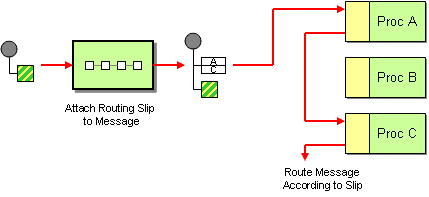Routing Slip

See the cacheSize option for more details on how much cache to use depending on how many or few unique endpoints are used.
|
Options
The Routing Slip EIP supports 3 options which are listed below:
| Name | Description | Default | Type |
|---|---|---|---|
uriDelimiter |
Sets the uri delimiter to use |
, |
String |
ignoreInvalidEndpoints |
Ignore the invalidate endpoint exception when try to create a producer with that endpoint |
false |
Boolean |
cacheSize |
Sets the maximum size used by the org.apache.camel.spi.ProducerCache which is used to cache and reuse producers when using this routing slip, when uris are reused. Beware that when using dynamic endpoints then it affects how well the cache can be utilized. If each dynamic endpoint is unique then its best to turn of caching by setting this to -1, which allows Camel to not cache both the producers and endpoints; they are regarded as prototype scoped and will be stopped and discarded after use. This reduces memory usage as otherwise producers/endpoints are stored in memory in the caches. However if there are a high degree of dynamic endpoints that have been used before, then it can benefit to use the cache to reuse both producers and endpoints and therefore the cache size can be set accordingly or rely on the default size (1000). If there is a mix of unique and used before dynamic endpoints, then setting a reasonable cache size can help reduce memory usage to avoid storing too many non frequent used producers. |
Integer |
Example
The following route will take any messages sent to the Apache ActiveMQ queue SomeQueue and pass them into the Routing Slip pattern.
from("activemq:SomeQueue")
.routingSlip("aRoutingSlipHeader");Messages will be checked for the existence of the aRoutingSlipHeader header.
The value of this header should be a comma-delimited list of endpoint URIs you wish the message to be routed to.
The Message will be routed in a pipeline fashion, i.e., one after the other. The Routing Slip sets a property, Exchange.SLIP_ENDPOINT, on the Exchange which contains the current endpoint as it advanced though the slip. This allows you to know how far we have processed in the slip.
The Routing Slip will compute the slip beforehand which means, the slip is only computed once. If you need to compute the slip on-the-fly then use the Dynamic Router pattern instead.
Configuration Options
Here we set the header name and the URI delimiter to something different.
#=== Using the Fluent Builders
from("direct:c").routingSlip(header("aRoutingSlipHeader"), "#");#=== Using the Spring XML Extensions
<camelContext id="buildRoutingSlip" xmlns="http://activemq.apache.org/camel/schema/spring">
<route>
<from uri="direct:c"/>
<routingSlip uriDelimiter="#">
<header>aRoutingSlipHeader</header>
</routingSlip>
</route>
</camelContext>Ignore Invalid Endpoints
The Routing Slip supports ignoreInvalidEndpoints which the Recipient List also supports. You can use it to skip endpoints which are invalid.
from("direct:a")
.routingSlip("myHeader")
.ignoreInvalidEndpoints();And in Spring XML its an attribute on the recipient list tag:
<route>
<from uri="direct:a"/>
<routingSlip ignoreInvalidEndpoints="true"/>
<header>myHeader</header>
</routingSlip>
</route>Then let’s say the myHeader contains the following two endpoints direct:foo,xxx:bar. The first endpoint is valid and works. However the second endpoint is invalid and will just be ignored. Camel logs at INFO level, so you can see why the endpoint was invalid.
Expression Support
The Routing Slip supports to take the expression parameter as the Recipient List does. You can tell Camel the expression that you want to use to get the routing slip.
from("direct:a")
.routingSlip(header("myHeader"))
.ignoreInvalidEndpoints();And in Spring XML its an attribute on the recipient list tag.
<route>
<from uri="direct:a"/>
<!--NOTE from Camel 2.4.0, you need to specify the expression element inside of the routingSlip element -->
<routingSlip ignoreInvalidEndpoints="true">
<header>myHeader</header>
</routingSlip>
</route>